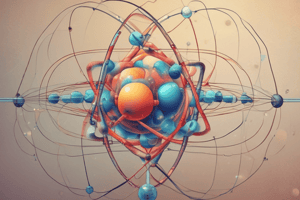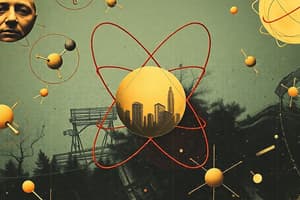Podcast
Questions and Answers
What are the three primary subatomic particles?
What are the three primary subatomic particles?
Protons, neutrons, and electrons
What charge do protons carry?
What charge do protons carry?
Positively charged
Where are electrons located in an atom?
Where are electrons located in an atom?
Orbit around the nucleus
Who discovered neutrons?
Who discovered neutrons?
The atomic number represents the number of neutrons in the nucleus.
The atomic number represents the number of neutrons in the nucleus.
The mass number is the sum of the number of protons and neutrons.
The mass number is the sum of the number of protons and neutrons.
Define isotopes.
Define isotopes.
How do isotopes differ?
How do isotopes differ?
The number of protons plus the number of neutrons equals the ______.
The number of protons plus the number of neutrons equals the ______.
Match the following particles with their charges:
Match the following particles with their charges:
The atomic number is equal to the number of ______.
The atomic number is equal to the number of ______.
Isotopes have the same atomic number?
Isotopes have the same atomic number?
Isotopes differ in the number of which particles?
Isotopes differ in the number of which particles?
Study Notes
Subatomic Particles
- Subatomic particles include protons, neutrons, and electrons; they are smaller than atoms.
- Protons carry a positive charge, are located in the nucleus, and were discovered by Ernest Rutherford in 1919.
- Neutrons are neutral particles, also found in the nucleus, discovered by James Chadwick in 1932.
- Electrons are negatively charged particles that orbit around the nucleus, discovered by J.J. Thomson in 1897.
Atom Structure
- An atom is the basic unit of matter and retains the properties of an element.
- The nucleus is extremely small, approximately 100,000 times smaller than the overall size of the atom.
- The mass of an atom comes almost entirely from protons and neutrons within the nucleus.
Atomic Number and Mass Number
- The atomic number equals the number of protons and defines the element.
- The mass number is the total of protons and neutrons in the nucleus.
- The relationship is expressed as: Mass Number = Number of Protons + Number of Neutrons.
Isotopes
- Isotopes are variants of an element with the same atomic number but different mass numbers due to differing numbers of neutrons.
- They retain the same chemical properties since they have the same number of protons and electrons.
- Isotopes can be detected and analyzed using mass spectroscopy.
Practical Applications of Isotopes
- Cobalt-60 is used in radiation therapy for cancer treatment.
- Iodine-131 is utilized in diagnosing and treating thyroid disease.
- Carbon-11 is used in positron emission tomography (PET) scans.
- Technetium-99 is widely used in medical imaging.
Key Principles
- The atomic number indicates the number of protons and is equal to the number of electrons in a neutral atom.
- The mass number provides an estimate of an element’s atomic mass by summing the protons and neutrons.
- Different isotopes of the same element can have different chemical properties due to mass differences.
True/False Statements
- The atomic number equals the number of protons. (True)
- The mass number sums protons and neutrons. (True)
- Isotopes comprise the same elements. (True)
- Isotopes have the same atomic number. (True)
- Isotopes share the same mass number. (False)
- Isotopes have the same number of neutrons. (False)
- Isotopes differ in the number of protons. (False)
- Isotopes possess different chemical properties. (True)
Studying That Suits You
Use AI to generate personalized quizzes and flashcards to suit your learning preferences.
Related Documents
Description
Explore the fundamental components of atoms in this quiz focused on General Chemistry 1. Identify protons, neutrons, and electrons, their properties, and how to calculate atomic and mass numbers. Understand isotopes and their variations in neutron count.




